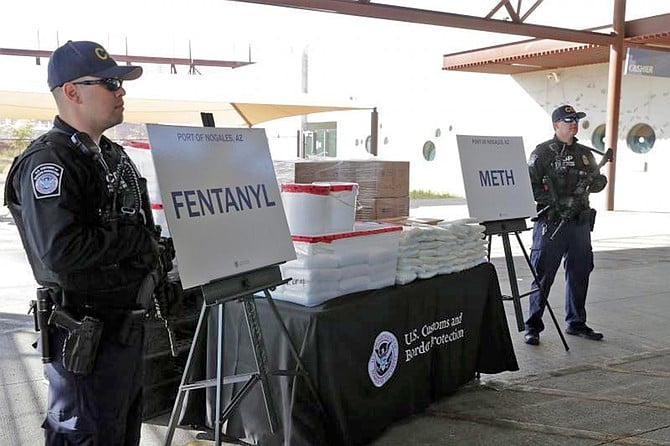 Facebook
Facebook
 X
X
 Instagram
Instagram
 TikTok
TikTok
 Youtube
Youtube

The U. S. Border Patrol is sitting on a vast horde of deadly illegal drugs collected over two decades, creating significant risks to the safety and security of the agency’s sprawling network of border storage vaults. So says a March 26 audit by the Department of Homeland Security’s Office of Inspector General. “Each year, [Customs and Border Protection] seizes hundreds of thousands of pounds of illegal drugs entering the United States and stores them in one of its 62 permanent seizure vaults,” says the document. “Between fiscal years 2014 and 2019, marijuana seizures decreased while seizures for more toxic and hazardous drugs such as cocaine, methamphetamines, and fentanyl increased.”

In a July 2019 report, auditors blasted Customs and Border Protection for “failure to protect its employees from possible fentanyl exposure.” Though not explicitly mentioned in that review, over 85 percent of total fentanyl seizures happened at San Diego border crossings. “In the report, we noted that as little as two milligrams of fentanyl could kill an individual,” In the public version of the new report, the Inspector-General redacted Border Patrol and Customs checkpoints’ names and vault locations where auditors monitored seizure operations. Before its release late last month, the entire report had been labeled Law Enforcement Sensitive. Despite the growing risks, Customs and Border Protection continues to stockpile dangerous drugs negligently, endangering workers and increasing costs. “In some instances, [Customs and Border Protection] stored excess drugs for more than 20 years,” per the document. “According to 1,184 case files we reviewed, between FYs 1984 and 2013, CBP’s Office of Field Operations stored almost 13,000 pounds of drugs exceeding established threshold amounts in its vaults instead of destroying them.”
Auditors reported that they discovered the agency “routinely circumvented its drug destruction process,” increasing “the risk of accidents, theft, and harmful drug exposure.” Customs and Border Protection is also vulnerable to “additional personnel costs necessary to manage the excess stored drugs.”
The federal agency vowed to make changes proposed by the audit. But a January 4 memo from official Henry A. Moak, Jr., said the draft document did “not sufficiently recognize challenges” facing the agency. Among them he listed “budget constraints,” “destruction facilities schedule/operations,” and “staffing shortages.”
Sempra Energy, whose subsidiary San Diego Gas & Electric is lobbying for a favorable extension to its exclusive city energy franchise, is a mainstay of the San Diego Regional Chamber of Commerce. Per an online accounting posted by the utility giant, Sempra backed the chamber, a staunch SDG&E advocate, with a total of $222,900 in 2020 membership fees. That put the San Diego chamber at number three on Sempra’s 2020 business membership list, under first place Chamber of Commerce of the United States at $1,020,000, and second-place holder Business Roundtable, with $600,000. In the fourth position was the American Petroleum Institute, at $200,000. The oil and gas industry’s largest trade group has historically opposed limits on carbon fuels to limit climate change. In early April, it agreed to support setting a price on carbon emissions in the post-Donald Trump era.

Many anti-carbon advocates are skeptical. “This is an effort to get to the table, rather than be overlooked and run roughshod, but it’s not very definite yet. I don’t know what they’re offering to really support,” David Doniger, climate and clean energy program director at the Natural Resources Defense Council, told CNBC.com. Other local business interests supported by Sempra include Economic Development Corporation - San Diego County ($87,500), San Diego Convention and Tourist Bureau ($40,000), San Diego North Economic Development Council ($37,500), Downtown San Diego Partnership ($35,000), San Diego Athena ($35,000), San Diego County Taxpayers Association ($33,500), San Diego Port Tenants Association ($30,104), and the East County Economic Development Council ($28,000)... As the effort to recall San Diego city council Democrat Jen Campbell announces it has already gathered 5000 signatures, a significant player in the so-called short-term rental market says it spent $6548 lobbying against a restrictive city ordinance. Airbnb, Inc. of San Rafael disclosed in an April 1 lobbying report filed by company attorney Joel Aurora, says the expenditure came in the final quarter of last year.
— Matt Potter
The Reader offers $25 for news tips published in this column. Call our voice mail at 619-235-3000, ext. 440, or sandiegoreader.com/staff/matt-potter/contact/.


The U. S. Border Patrol is sitting on a vast horde of deadly illegal drugs collected over two decades, creating significant risks to the safety and security of the agency’s sprawling network of border storage vaults. So says a March 26 audit by the Department of Homeland Security’s Office of Inspector General. “Each year, [Customs and Border Protection] seizes hundreds of thousands of pounds of illegal drugs entering the United States and stores them in one of its 62 permanent seizure vaults,” says the document. “Between fiscal years 2014 and 2019, marijuana seizures decreased while seizures for more toxic and hazardous drugs such as cocaine, methamphetamines, and fentanyl increased.”

In a July 2019 report, auditors blasted Customs and Border Protection for “failure to protect its employees from possible fentanyl exposure.” Though not explicitly mentioned in that review, over 85 percent of total fentanyl seizures happened at San Diego border crossings. “In the report, we noted that as little as two milligrams of fentanyl could kill an individual,” In the public version of the new report, the Inspector-General redacted Border Patrol and Customs checkpoints’ names and vault locations where auditors monitored seizure operations. Before its release late last month, the entire report had been labeled Law Enforcement Sensitive. Despite the growing risks, Customs and Border Protection continues to stockpile dangerous drugs negligently, endangering workers and increasing costs. “In some instances, [Customs and Border Protection] stored excess drugs for more than 20 years,” per the document. “According to 1,184 case files we reviewed, between FYs 1984 and 2013, CBP’s Office of Field Operations stored almost 13,000 pounds of drugs exceeding established threshold amounts in its vaults instead of destroying them.”
Auditors reported that they discovered the agency “routinely circumvented its drug destruction process,” increasing “the risk of accidents, theft, and harmful drug exposure.” Customs and Border Protection is also vulnerable to “additional personnel costs necessary to manage the excess stored drugs.”
The federal agency vowed to make changes proposed by the audit. But a January 4 memo from official Henry A. Moak, Jr., said the draft document did “not sufficiently recognize challenges” facing the agency. Among them he listed “budget constraints,” “destruction facilities schedule/operations,” and “staffing shortages.”
Sempra Energy, whose subsidiary San Diego Gas & Electric is lobbying for a favorable extension to its exclusive city energy franchise, is a mainstay of the San Diego Regional Chamber of Commerce. Per an online accounting posted by the utility giant, Sempra backed the chamber, a staunch SDG&E advocate, with a total of $222,900 in 2020 membership fees. That put the San Diego chamber at number three on Sempra’s 2020 business membership list, under first place Chamber of Commerce of the United States at $1,020,000, and second-place holder Business Roundtable, with $600,000. In the fourth position was the American Petroleum Institute, at $200,000. The oil and gas industry’s largest trade group has historically opposed limits on carbon fuels to limit climate change. In early April, it agreed to support setting a price on carbon emissions in the post-Donald Trump era.

Many anti-carbon advocates are skeptical. “This is an effort to get to the table, rather than be overlooked and run roughshod, but it’s not very definite yet. I don’t know what they’re offering to really support,” David Doniger, climate and clean energy program director at the Natural Resources Defense Council, told CNBC.com. Other local business interests supported by Sempra include Economic Development Corporation - San Diego County ($87,500), San Diego Convention and Tourist Bureau ($40,000), San Diego North Economic Development Council ($37,500), Downtown San Diego Partnership ($35,000), San Diego Athena ($35,000), San Diego County Taxpayers Association ($33,500), San Diego Port Tenants Association ($30,104), and the East County Economic Development Council ($28,000)... As the effort to recall San Diego city council Democrat Jen Campbell announces it has already gathered 5000 signatures, a significant player in the so-called short-term rental market says it spent $6548 lobbying against a restrictive city ordinance. Airbnb, Inc. of San Rafael disclosed in an April 1 lobbying report filed by company attorney Joel Aurora, says the expenditure came in the final quarter of last year.
— Matt Potter
The Reader offers $25 for news tips published in this column. Call our voice mail at 619-235-3000, ext. 440, or sandiegoreader.com/staff/matt-potter/contact/.
Comments